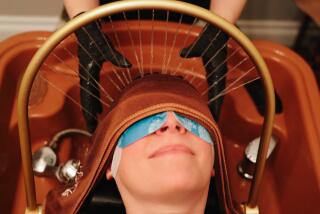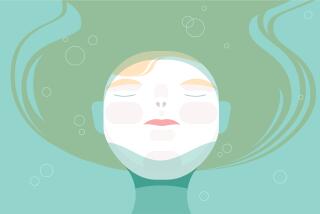Good for what ails them: Russians swear by deer
- Share via
NIZHNEKAYANCHA, RUSSIA — This patch of Siberia nestled above the Kazakh steppe beckons tourists with awe-inspiring nature. The Katun River’s rapids are world class. More than 7,000 lakes adorn meadowy hillocks and vast stands of white birch. Above it all tower the majestic, snowcapped peaks of the Altai range.
Another natural attraction, however, lures Russia’s nouveaux riches here: the maral deer -- its blood and antlers, to be exact.
Every summer, farmworkers saw off the antlers of thousands of maral deer a few months before they are naturally shed, boil the antlers in vats and use the murky soup to produce baths and steam treatments treasured by many Russians as a cure for everything from arthritis to impotence.
For an extra jolt of health, devotees swig shots of maral deer blood sweetened with fruit syrup.
“I drink the blood of maral every day in the morning for a month,” says Sergei Trubchaninov, 46, a supermarket executive from Kemerovo. Red-faced as he bastes in a barrel-shaped personal sauna that infuses his skin with vaporized maral blood, Trubchaninov describes his wake-up cocktail: “thirty grams’ worth, 50% blood, 50% vodka.”
The spa trade is big business in Russia. Moscow’s moneyed elite flocks to downtown spas offering Botox, body wraps and cosmetic stem cell treatments. The blood of the maral deer, however, has a cachet all its own.
Russians believe a substance called pantogematogen found in the bloody ooze from the antlers has unique curative properties that work on a cellular level. Every year they show up at Altai resorts hoping the blood baths, steam treatments and maral blood-infused massages will fend off a laundry list of disorders: ulcers, heart disease, atherosclerosis, achy joints and sleep disorders. Middle-age Russian men look to pantogematogen for a Viagra-like chance at virility.
Russian health researchers say their studies support those beliefs. Scientists at the Siberian branch of the Russian Academy of Medical Sciences say years of research and clinical trials have convinced them that pantogematogen can be used to treat a number of maladies, including cardiovascular disease, arthritis, ulcers, impotence and infertility.
“At first we were skeptical,” said Nikolai Suslov, a pharmacologist at the academy’s laboratory in Tomsk. “But after we went there ourselves and tried the baths, we concluded that this substance possesses the attributes that are advertised.”
It’s not the studies, however, that draw Russians to the Altais. Word of mouth is a much more powerful sell for the region’s spas and the deer farms that supply them.
“I saw that my friends who had come here were full of joy, merry all the time and energetic,” said Eduard Nikonov, 39, an executive at a polygraph design company in Moscow. “I wanted to become the same.”
At first glance, spas in the Altai region that offer maral deer therapy appear to be a notch below what most wealthy Russians expect from a vacation hot spot. At the Parma resort in the village of Nizhnekayancha, guest cabins are clean but small. Pigs and cows forage through rapeseed fields ringing the spa’s grounds. Buckwheat porridge and fruit compote take the place of caviar and lattes on the Parma menu.
But the executives who make yearly pilgrimages to Parma say they come for the baths, not for frills.
“I feel this energy when I’m in the bath,” says Vladimir Dobrev, 54, a businessman from Krasnodar. He says he relies on the treatments to cope with arthritis. “We buy a big box of the maral blood every time we come here. There’s no place in the car for all the bottles we buy.”
Deer antlers have been used in folk medicine for centuries. Antlers from maral deer, however, are coveted because their growth is turbocharged. Maral antlers reach a weight of 55 pounds in just two months, Suslov says.
“This metabolic capability,” he says, “can be harnessed for medical purposes.”
For the Altai region, the maral antler market props up a fragile economy ravaged by the Soviet collapse in 1991 and the lean years that followed.
An estimated 80,000 maral deer live in the Altai expanse, and a pound of antler fetches about $180. At least 160 deer farms and spas operate here. A portion of the Altai’s yearly haul of maral antler gets shipped to South Korea and China, where it is ground into powder for folk medicines. Local pharmacies and kiosks stock pantogematogen by the pill and by the bottle. The substance also is available worldwide through a host of dietary supplement websites.
At Parma, a room and a 14-day regimen of pantogematogen baths and saunas cost $1,000.
The baths themselves are a curious sight. Bare walls and a weathered parquet floor provide an ambience expected in a city clinic. Tubs are lined up along a small hallway, separated only by thin pieces of white sheet metal. The water is tawny-yellow; its aroma carries a slight tang. A medical technician checks customers’ pulses every few minutes. Afterward, he gives every bather a half shot of maral deer blood served in a silver shot glass. Fruit syrup is added as a preservative, and because “blood by itself doesn’t taste very good,” says Vyacheslav Safonov, who runs Parma with his father, Valery.
At the deer farms, antlers are cut every May and June. Farmworkers say the deer feels pain while the cutting takes place but that its life is not endangered. On a recent morning at the New Way Farm in the village of Dektiyek, a six-man crew collected 220 pounds of antler from 13 deer, an hour’s work that should bring in about $40,000.
Each deer was herded into a chute, where two workers steadied the animal’s head. Another worker stood on the deer’s back. In a matter of seconds, crew chief Alexander Yegarmin sawed off one antler, then the other. After another worker dabbed a powdery salve on the animal’s open wounds, the deer bounded out of the chute toward a thicket of birch and pine.
Each antler was weighed, hung on a rack and dunked into a steaming caldron that eventually would yield the liquid used in the baths and saunas.
Pavel Starikov, 70, a retired Moscow economist who returns to the Altais every year for a round of maral baths, shrugged as he looked on, saying, “They would shake off their antlers in autumn anyway.”
More to Read
Sign up for The Wild
We’ll help you find the best places to hike, bike and run, as well as the perfect silent spots for meditation and yoga.
You may occasionally receive promotional content from the Los Angeles Times.






